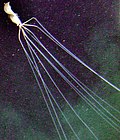A cephalopod /ˈsɛfələpɒd/ is any member of the molluscan class Cephalopoda /sɛfəˈlɒpədə/ (Greek plural κεφαλόποδες, kephalópodes; "head-feet") such as...
140 KB (15,695 words) - 07:33, 6 April 2025
Cephalopod ink is a dark-coloured or luminous ink released into water by most species of cephalopod, usually as an escape mechanism. All cephalopods, with...
14 KB (1,556 words) - 04:17, 22 March 2025
Cephalopods, which include squids and octopuses, vary enormously in size. The smallest are only about 1 centimetre (0.39 in) long and weigh less than...
359 KB (29,840 words) - 20:45, 28 March 2025
Cephalopod intelligence is a measure of the cognitive ability of the cephalopod class of molluscs. Intelligence is generally defined as the process of...
31 KB (3,027 words) - 07:01, 1 April 2025
The cephalopods have a long geological history, with the first nautiloids found in late Cambrian strata. The class developed during the middle Cambrian...
37 KB (4,188 words) - 05:39, 9 February 2025
Cephalopod fins, sometimes known as wings, are paired flap-like locomotory appendages. They are found in ten-limbed cephalopods (including squid, bobtail...
7 KB (650 words) - 03:38, 29 December 2023
Vertebrate Octopus Cephalopods, as active marine predators, possess sensory organs specialized for use in aquatic conditions. They have a camera-type...
11 KB (1,278 words) - 09:43, 2 March 2025
All cephalopods possess flexible limbs extending from their heads and surrounding their beaks. These appendages, which function as muscular hydrostats...
15 KB (1,267 words) - 12:28, 5 October 2024
Coleoidea (redirect from Soft-bodied cephalopods)
Coleoidea or Dibranchiata is one of the two subclasses of cephalopod molluscs containing all the various taxa popularly thought of as "soft-bodied" or...
19 KB (1,856 words) - 13:45, 13 April 2025
All extant cephalopods have a two-part beak, or rostrum, situated in the buccal mass and surrounded by the muscular head appendages. The dorsal (upper)...
16 KB (1,924 words) - 20:32, 16 April 2025
between two adjacent septa in the phragmocone of a nautiloid or ammonoid cephalopod molluscus. These can be seen in cross-sections of a nautilus shell and...
1 KB (131 words) - 04:55, 21 May 2024
gladius (pl.: gladii), or pen, is a hard internal bodypart found in many cephalopods of the superorder Decapodiformes (particularly squids) and in a single...
7 KB (445 words) - 09:37, 11 April 2025
partitions between the internal chambers (camerae) of the shell of a cephalopod, namely nautiloids or ammonoids. As the creature grows, its body moves...
3 KB (373 words) - 10:36, 23 June 2024
Crioceras is an extinct cephalopod genus belonging to the subclass Ammonoidea and included in the family Crioceratidae of the ammonitid superfamily Ancylocerataceae...
2 KB (89 words) - 23:43, 29 April 2022
class Cephalopoda with squids, cuttlefish, and nautiloids. Like other cephalopods, an octopus is bilaterally symmetric with two eyes and a beaked mouth...
104 KB (10,863 words) - 02:27, 18 April 2025
Squid (category Cenozoic cephalopods)
called squid despite not strictly fitting these criteria). Like all other cephalopods, squid have a distinct head, bilateral symmetry, and a mantle. They are...
67 KB (6,860 words) - 07:35, 13 April 2025
Nautiloid (category Paleozoic cephalopods)
Nautiloids are a group of marine cephalopods (Mollusca) which originated in the Late Cambrian and are represented today by the living Nautilus and Allonautilus...
37 KB (3,465 words) - 16:00, 20 December 2024
Cephalopod attacks on humans have been reported since ancient times. A significant portion of these attacks are questionable or unverifiable tabloid stories...
23 KB (2,989 words) - 18:32, 20 March 2025
(nautílos) 'little sailor') is any of the various species within the cephalopod family Nautilidae. This is the sole extant family of the superfamily Nautilaceae...
55 KB (5,549 words) - 02:38, 14 April 2025
Mantle (mollusc) (redirect from Mantle (cephalopod))
chamber, and in cephalopods and some bivalves such as scallops, it is a locomotory organ. The mantle is highly muscular. In cephalopods the contraction...
6 KB (628 words) - 10:00, 29 December 2024
Cuttlefish (category Cenozoic cephalopods)
relatives. Cuttlefish, like other cephalopods, have sophisticated eyes. The organogenesis and the final structure of the cephalopod eye fundamentally differ from...
57 KB (6,346 words) - 01:05, 13 April 2025
Siphon (mollusc) (redirect from Funnel (cephalopod))
gastropods. In those bivalves which have siphons, the siphons are paired. In cephalopods, there is a single siphon or funnel which is known as a hyponome. In...
12 KB (1,313 words) - 22:22, 30 December 2024
Kraken (category Mythological cephalopods)
legendary sea monster of enormous size, per its etymology something akin to a cephalopod, said to appear in the sea between Norway and Iceland. It is believed...
120 KB (12,168 words) - 22:50, 12 March 2025
Orthoceras (redirect from Orthoceras (cephalopod))
"straight", and κέρας (kéras), meaning "horn", is a genus of extinct nautiloid cephalopod restricted to Middle Ordovician-aged marine limestones of the Baltic States...
5 KB (449 words) - 14:54, 22 March 2025
Hamites (genus) (redirect from Hamites (extinct cephalopod))
Hamites ("hook-like") is a genus of heteromorph ammonite that evolved late in the Aptian stage of the Early Cretaceous and lasted into the Cenomanian stage...
8 KB (741 words) - 22:40, 25 January 2025
Cephalopods, usually specifically octopuses, squids, nautiluses and cuttlefishes, are most commonly represented in popular culture in the Western world...
14 KB (1,654 words) - 22:32, 6 February 2025
Examples of cephalopds Pain in cephalopods is a contentious issue. Pain is a complex mental state, with a distinct perceptual quality but also associated...
63 KB (7,240 words) - 04:58, 11 December 2024
Bigfin squid (category Cephalopod genera)
Bigfin squids are a group of rarely seen cephalopods with a distinctive morphology. They are placed in the genus Magnapinna and family Magnapinnidae....
26 KB (2,894 words) - 15:41, 17 April 2025
Huronia is an actinocerid genus included in the Huroniidae along with Discoactinoceras and Huroniella,(Teichert 1964). Huronia is characterized by long...
3 KB (287 words) - 09:47, 20 February 2025

























